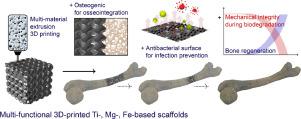当前位置:
X-MOL 学术
›
Acta Biomater.
›
论文详情
Our official English website, www.x-mol.net, welcomes your
feedback! (Note: you will need to create a separate account there.)
Multi-material additive manufacturing technologies for Ti-, Mg-, and Fe-based biomaterials for bone substitution.
Acta Biomaterialia ( IF 9.4 ) Pub Date : 2020-04-06 , DOI: 10.1016/j.actbio.2020.03.037 N E Putra 1 , M J Mirzaali 1 , I Apachitei 1 , J Zhou 1 , A A Zadpoor 1
Acta Biomaterialia ( IF 9.4 ) Pub Date : 2020-04-06 , DOI: 10.1016/j.actbio.2020.03.037 N E Putra 1 , M J Mirzaali 1 , I Apachitei 1 , J Zhou 1 , A A Zadpoor 1
Affiliation

|
The growing interest in multi-functional metallic biomaterials for bone substitutes challenges the current additive manufacturing (AM, =3D printing) technologies. It is foreseeable that advances in multi-material AM for metallic biomaterials will not only allow for complex geometrical designs, but also improve their multi-functionalities by tuning the types or compositions of the underlying base materials, thereby presenting unprecedented opportunities for advanced orthopedic treatments. AM technologies are yet to be extensively explored for the fabrication of multi-functional metallic biomaterials, especially for bone substitutes. The aim of this review is to present the viable options of the state-of-the-art multi-material AM for Ti-, Mg-, and Fe-based biomaterials to be used as bone substitutes. The review starts with a brief review of bone tissue engineering, the design requirements, and fabrication technologies for metallic biomaterials to highlight the advantages of using AM over conventional fabrication methods. Five AM technologies suitable for metal 3D printing are compared against the requirements for multi-material AM. Of these AM technologies, extrusion-based multi-material AM is shown to have the greatest potential to meet the requirements for the fabrication of multi-functional metallic biomaterials. Finally, recent progress in the fabrication of Ti-, Mg-, and Fe-based biomaterials including the utilization of multi-material AM technologies is reviewed so as to identify the knowledge gaps and propose the directions of further research for the development of multi-material AM technologies that are applicable for the fabrication of multi-functional metallic biomaterials. STATEMENT OF SIGNIFICANCE: Addressing a critical bone defect requires the assistance of multi-functional porous metallic bone substitutes. As one of the most advanced fabrication technology in bone tissue engineering, additive manufacturing is challenged for its viability in multi-material fabrication of metallic biomaterials. This article reviews how the current metal additive manufacturing technologies have been and can be used for multi-material fabrication of Ti-, Mg-, and Fe-based bone substitutes. Progress on the Ti-, Mg-, and Fe-based biomaterials, including the utilization of multi-material additive manufacturing, are discussed to direct future research for advancing the multi-functional additively manufactured metallic bone biomaterials.
中文翻译:

用于骨骼替代的Ti,Mg和Fe基生物材料的多材料增材制造技术。
对用于骨骼替代物的多功能金属生物材料的兴趣日益增长,这对当前的增材制造(AM,= 3D打印)技术提出了挑战。可以预见的是,用于金属生物材料的多材料增材制造的发展不仅将允许进行复杂的几何设计,而且还将通过调整基础材料的类型或组成来提高其多功能性,从而为先进的骨科治疗提供了前所未有的机会。AM技术在多功能金属生物材料(尤其是骨替代品)的制造方面尚未得到广泛探索。这篇综述的目的是为钛,镁和铁基生物材料提供最先进的多种材料增材制造的可行选择,以用作骨替代品。本文首先简要回顾了骨组织工程,金属生物材料的设计要求和制造技术,以强调使用AM优于传统制造方法的优势。将五种适用于金属3D打印的增材制造技术与多材料增材制造的要求进行了比较。在这些增材制造技术中,基于挤压的多材料增材制造具有最大的潜力,可以满足多功能金属生物材料的制造要求。最后,Ti-,Mg-,对包括多材料增材制造技术的利用在内的铁基生物材料进行了综述,以识别知识差距,并提出了进一步研究方向,以开发适用于制造多功能金属材料的多材料增材制造技术。生物材料。意义声明:解决严重的骨缺损需要多功能多孔金属骨替代物的协助。作为骨组织工程中最先进的制造技术之一,增材制造在金属生物材料的多材料制造中的生存能力受到了挑战。本文回顾了当前的金属增材制造技术如何并将其用于基于Ti,Mg和Fe的骨替代物的多材料制造。钛,镁,
更新日期:2020-04-06
中文翻译:

用于骨骼替代的Ti,Mg和Fe基生物材料的多材料增材制造技术。
对用于骨骼替代物的多功能金属生物材料的兴趣日益增长,这对当前的增材制造(AM,= 3D打印)技术提出了挑战。可以预见的是,用于金属生物材料的多材料增材制造的发展不仅将允许进行复杂的几何设计,而且还将通过调整基础材料的类型或组成来提高其多功能性,从而为先进的骨科治疗提供了前所未有的机会。AM技术在多功能金属生物材料(尤其是骨替代品)的制造方面尚未得到广泛探索。这篇综述的目的是为钛,镁和铁基生物材料提供最先进的多种材料增材制造的可行选择,以用作骨替代品。本文首先简要回顾了骨组织工程,金属生物材料的设计要求和制造技术,以强调使用AM优于传统制造方法的优势。将五种适用于金属3D打印的增材制造技术与多材料增材制造的要求进行了比较。在这些增材制造技术中,基于挤压的多材料增材制造具有最大的潜力,可以满足多功能金属生物材料的制造要求。最后,Ti-,Mg-,对包括多材料增材制造技术的利用在内的铁基生物材料进行了综述,以识别知识差距,并提出了进一步研究方向,以开发适用于制造多功能金属材料的多材料增材制造技术。生物材料。意义声明:解决严重的骨缺损需要多功能多孔金属骨替代物的协助。作为骨组织工程中最先进的制造技术之一,增材制造在金属生物材料的多材料制造中的生存能力受到了挑战。本文回顾了当前的金属增材制造技术如何并将其用于基于Ti,Mg和Fe的骨替代物的多材料制造。钛,镁,











































 京公网安备 11010802027423号
京公网安备 11010802027423号